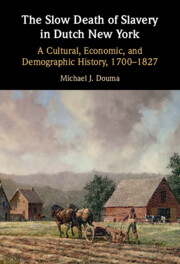 The Slow Death of Slavery in Dutch New York
The Slow Death of Slavery in Dutch New York Emancipation by the Numbers in Dutch New York
Published online by Cambridge University Press: 20 December 2024
Chapter 5 addresses a major demographic puzzle concerning thousands of New York slaves who seem to have gone missing in the transition from slavery to freedom, and the chapter questions how and if slaves were sold South. The keys to solving this puzzle include estimates of common death rates, census undercounting, changing gender ratios in the New York black population, and, most importantly, a proper interpretation of the 1799 emancipation law and its effects on how the children of slaves were counted in the census. Given an extensive analysis of census data, with various demographic techniques for understanding how populations change over time, I conclude that a large number of New York slaves (between 1,000 and 5,000) were sold South, but not likely as many as some previous historians have suggested. A disproportionate number of these sold slaves came from Long Island and Manhattan.
To save this book to your Kindle, first ensure [email protected] is added to your Approved Personal Document E-mail List under your Personal Document Settings on the Manage Your Content and Devices page of your Amazon account. Then enter the ‘name’ part of your Kindle email address below. Find out more about saving to your Kindle.
Note you can select to save to either the @free.kindle.com or @kindle.com variations. ‘@free.kindle.com’ emails are free but can only be saved to your device when it is connected to wi-fi. ‘@kindle.com’ emails can be delivered even when you are not connected to wi-fi, but note that service fees apply.
Find out more about the Kindle Personal Document Service.
To save content items to your account, please confirm that you agree to abide by our usage policies. If this is the first time you use this feature, you will be asked to authorise Cambridge Core to connect with your account. Find out more about saving content to Dropbox.
To save content items to your account, please confirm that you agree to abide by our usage policies. If this is the first time you use this feature, you will be asked to authorise Cambridge Core to connect with your account. Find out more about saving content to Google Drive.